As noted in my description of my 1997-1998 digital series Lunar Threads, my digital practice had by that time become increasingly frustrating. My demands were outstripping the performance of my computer. I hadn’t been able to figure out where my work fit into the marketplace at a time when most pictorial digital media artists I was familiar with were working in photo-based practices. In contrast to this, I have always seen my digital work as a drawing-based, painting-influenced practice. By 1998 I was also no longer hindered by the studio interruptions that had all but forced me away from painting in acrylics. Add to this the acquisition of some small woodworking tools—especially a high-speed rotary tool with carving bits—and a ready supply of scrap lumber from our home renovations, and I started to play with material-based artworks again in early 1998.
As I noted in the Introduction, there are really two separate bodies of work in this period. For both, my working process was similar to that of the digital work in that I would start with a sketch and render it in the new medium. The first body of work, in painted and carved—but not assembled—wood was a series of “portraits” of imaginary mystical figures. I made over twenty of these pieces, each of which consists of the image carved in low-relief into the surface of a 3/4-inch thick plank about 9″ x 5.5″ (1.9cm thick; 22.5cm x 13.75cm) in size. In fact, the first two weeks of 1998 saw me produce fourteen pieces, one per day. I identify the medium as “Mixed Media (Acrylic on Carved Wood),” and though I now call this work a series, I wasn’t thinking about the work serially as I made it.
The next step was to break out of rectilinear space and start cutting the figures and other compositional elements out of individual pieces of wood then use a collage-like process to make them into what I call two-and-a-half-dimensional painted and carved wooden assemblages. To help differentiate them from the small “portraits,” in most cases I refer to this medium as “Mixed Media (Acrylic on Carved Wood Assemblage).” The first of these assemblages was Conversations on the Shore of the Burning Sea, which I assembled and carved in December 1998, and painted in March 1999. More such work followed, becoming in general larger and more complex. I made approximately thirty-eight of these larger works, as well as occasionally making more of the smaller and simpler carved portraits. I continued with these wall reliefs until I started The Meeting Place—a collection of sixteen small freestanding figures—in early 2002. The idea for this piece started as a maquette for larger work but evolved into a standalone piece. While I see the group of sixteen figures as a single piece within the oeuvre of my carved wooden assembages, it could conceivably be looked at as another distinct small body of work. The Meeting Place served as a starting point for my Crossroads installation of 2002, and acts as a bridge between my primarily wall-based assemblages and the fully sculptural Crossroads.
Returning to the subject of the carved wood assemblages, for the most part each piece was conceived of or executed separately. Rather than thinking in series as I had with my digital work, I concentrated on making individual pieces that could stand on their own. This was partly influenced by the lack of large blocks of continuous studio time and the larger time commitment that each of these works required. I found that I was fully occupied by each piece without any extra energy available for developing a grand plan for the work. Because of the preciousness of studio time I would often break up the process into task-based blocks: one day I would make assemblages in my wood workshop, another day I would carve the assemblages, and then I’d have a ready supply of objects ready for days I set aside for painting.
In February 2001 I went for one week to the writers’ and artists’ colony at St. Peter’s Abbey in Muenster, Saskatchewan, as part of the Saskatchewan Writers Guild’s winter colony program.1 In preparation, I made a number of unpainted carved assemblages because I knew I would have full days of studio time in which to paint. As well, I knew that I wouldn’t have as easy access to tools nor the freedom to make the kinds of mess that I had in my home workshop. The colony became about painting, and the weeks leading up to it became about preparing for painting. By the end of the first five days of the colony I had painted all eight assemblages I had brought with me. They were some of my largest works in this medium to date, and at that time some of my strongest. The Incandescent Leaves and The One Who Shines Brightest are two of the eight pieces I painted at the colony.
It is with the painted wooden assemblages that I received the most recognition. I exhibited them in a number of venues, ranging from coffee shops and restaurants to a new-age book store and the gallery of the Saskatchewan Craft Council. I found, however, that the combined labels of “craft” and “spiritual” were making it increasingly difficult for me to establish myself credibly in fine art circles. I found myself wanting to break out of the assumptions people had started to make about me and my work. The most irritating of these assumptions was that I was a craft-based decorative colourist working with new-age imagery. Partly motivated by this desire to change perceptions of my work, in late 2001 I started planning Crossroads, a large sculptural installation project which I completed in 2002. I am, however, looking forward to making new painted assemblages. It’s likely that when I do so I will integrate some of the methods and practices I developed while creating Encounters.
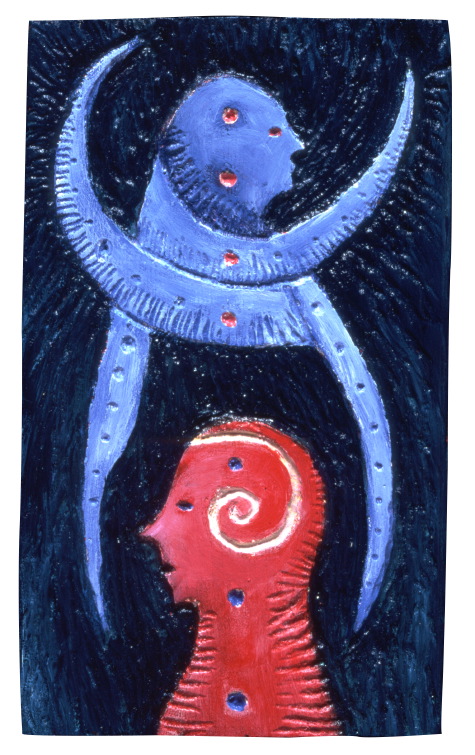
Birthing The Soul (1998)
Mixed Media (Acrylic on Carved Wood), 5.56″ x 9.12″ x 0.8″ (13.9cm x 22.8cm x 2cm)
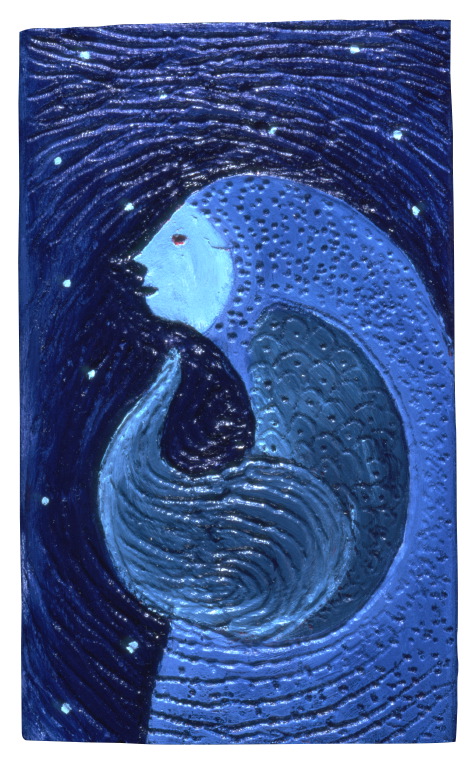
The Soul’s Midwife (1998)
Mixed Media (Acrylic on Carved Wood), 5.52″ x 9.12″ x 0.8″ (13.8cm x 22.8cm x 2cm)
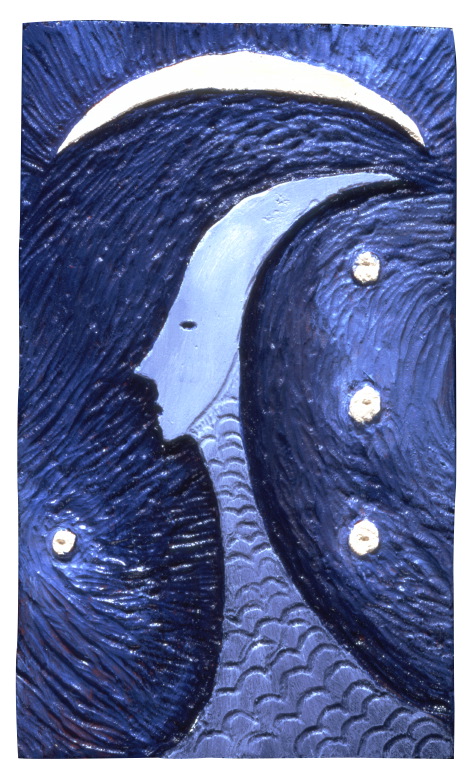
Lunar Guide (1998)
Mixed Media (Acrylic on Carved Wood), 5.52″ x 9.24″ x 0.72″ (13.8cm x 23.1cm x 1.8cm)

Illumination (1999)
Mixed Media (Acrylic on Carved Wood), 5.52″ x 9.24″ x 0.72″ (13.8cm x 23.1cm x 1.8cm)
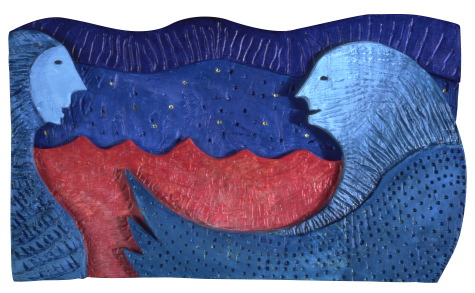
Conversation on the Shore of the Burning Sea (1999)
Mixed Media (Acrylic on Carved Wood Assemblage), 20.6″ x 12″ x 0.68″ (51.5cm x 30cm x 1.7cm)
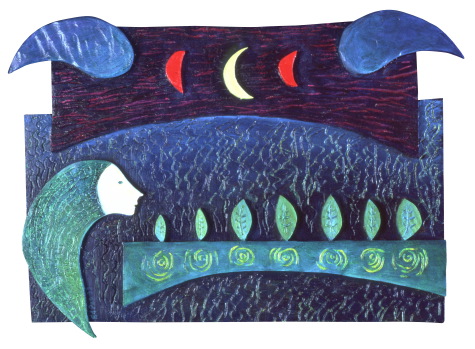
In the Hanging Garden: Persephone’s Bridge (1999)
Mixed Media (Acrylic on Carved Wood Assemblage), 17.28″ x 12.2″ x 0.92″ (43.2cm x 30.5cm x 2.3cm)
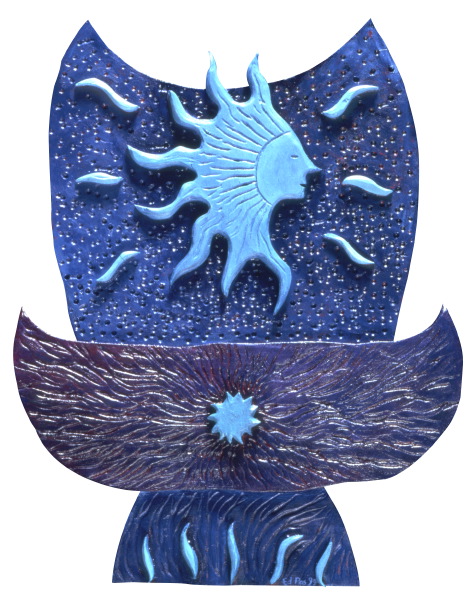
Return to the Flames of the Deep (1999)
Mixed Media (Acrylic on Carved Wood Assemblage), 13.68″ x 17.4″ x 0.96″ (34.2cm x 43.5cm x 2.4cm)

The Incandescent Leaves (2001)
Mixed Media (Acrylic on Carved Wood Assemblage), 25.52″ x 11.68″ x 1.2″ (63.8cm x 29.2cm x 3cm)

The One Who Shines Brightest (2001)
Mixed Media (Acrylic on Carved Wood Assemblage), 36.32″ x 19.32″ x 1.4″ (90.8cm x 48.3cm x 3.5cm

Wind and Water: Spreading the Seeds of Renewal (2002)
Mixed Media (Acrylic on Carved Wood Assemblage), 51″ x 36″ x 1.72″ (127.5cm x 90cm x 4.3cm)
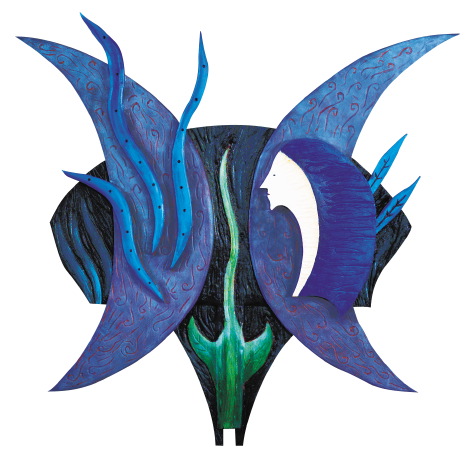
Moon Gate II: Night of the Sprouting Seed (2002)
Mixed Media (Acrylic on Carved Wood Assemblage), 29.2″ x 29.2″ x 1.44″ 73cm x 73cm x 3.6cm
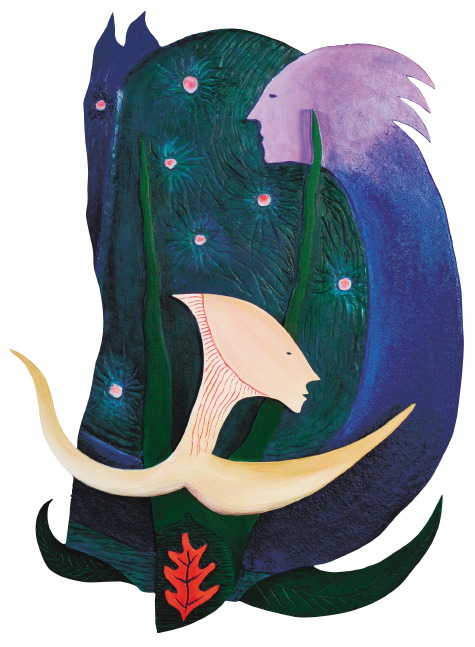
Awakening the Serpentine Flame (2002)
Mixed Media (Acrylic on Carved Wood Assemblage), 24.2″ x 33.2″ x 1.72″ (60.5cm x 83cm x 4.3cm)

The Meeting Place, overall view (2002)
Mixed Media (Acrylic on Carved Wood Assemblage), approximately 10″ x 48″ x 48″ (25cm x 120cm x 120cm)
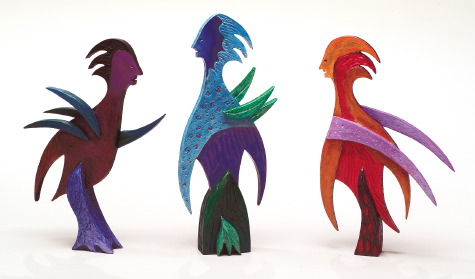
The Meeting Place, figure detail (2002)
Mixed Media (Acrylic on Carved Wood Assemblage)
Left to right:
The Messenger, 6.2″ x 9.12″ x 1.12″ (15.5cm x 22.8cm x 2.8cm)
The Alchemist, 4.84″ x 10.12″ x 1.88″ (12.1cm x 25.3cm x 4.7cm)
The Firebird, 5.6″ x 9.32″ x 1.12″ (14cm x 23.3cm x 2.8cm)
FOOTNOTES
- At the time I participated in the colony it was a kind of retreat for writers and artists with the main focus on individuals working on self-directed projects. While some socializing did take place, networking was not the goal of the program. Nor was critique, training, or directed group activities. ^